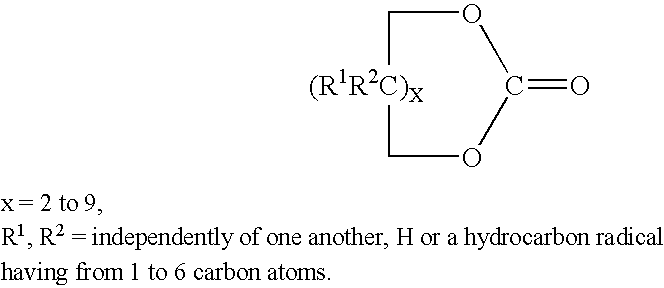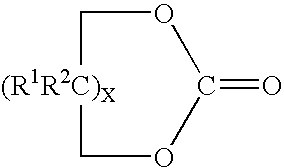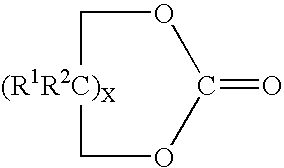Method of using cyclic organic carbonates as additives in the production of polyurethane foams
a technology of organic carbonates and additives, applied in the field of polyurethane foams, can solve the problems of non-uniform defects, lack of completely defect-free foams, and loss of attractiveness of polyurethane foams, and achieve the effects of reducing scorching, increasing the brittleness of the foam formed, and high formation tendency
- Summary
- Abstract
- Description
- Claims
- Application Information
AI Technical Summary
Benefits of technology
Problems solved by technology
Method used
Image
Examples
Embodiment Construction
[0020] A flexible polyurethane foam was produced in a 27.times.27 cm open wooden box having a wall height of 27 cm by foaming a polyurethane formulation comprising the following constituents:
[0021] 100 parts of a trifunctional polypropylene glycol having an OH number of 56,
[0022] 4.05 parts of water,
[0023] 0.2 part of a tertiary amine catalyst,
[0024] 0.2 part of tin octoate,
[0025] 3.0 parts of a physical blowing agent
[0026] and a 1.12-fold molar amount, based on the hydroxyl groups present in the formulation, of isocyanate groups in the form of the 80:20 mixture of the 2,4 and 2,6 isomers of tolylene diisocyanate, known as T80.
[0027] A silicone-polyether copolymer known as BC 2555, obtainable by hydrosilylation of Si--H-containing siloxanes using allyl-initiated polyethers and corresponding to an Si--C stabilizer as described, for example, in U.S. Pat. No. 5,321,051, incorporated herein by reference, was used as foam-stabilizing agent to stabilize the foams formed. In the examples a...
PUM
| Property | Measurement | Unit |
|---|---|---|
| Fraction | aaaaa | aaaaa |
| Fraction | aaaaa | aaaaa |
| Fraction | aaaaa | aaaaa |
Abstract
Description
Claims
Application Information
 Login to View More
Login to View More - R&D
- Intellectual Property
- Life Sciences
- Materials
- Tech Scout
- Unparalleled Data Quality
- Higher Quality Content
- 60% Fewer Hallucinations
Browse by: Latest US Patents, China's latest patents, Technical Efficacy Thesaurus, Application Domain, Technology Topic, Popular Technical Reports.
© 2025 PatSnap. All rights reserved.Legal|Privacy policy|Modern Slavery Act Transparency Statement|Sitemap|About US| Contact US: help@patsnap.com



